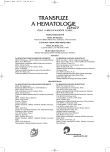Kaposi’s sarcoma after non-myeloablative allogeneic peripheral stem cell transplantation – case report
Authors:
S. Vokurka 1; D. Kazakov 2; V. Koza 1; K. Pizinger 3; V. Vozobulová 1; M. Švojgrová 1
Authors‘ workplace:
Hematologicko-onkologické oddělení, Fakultní nemocnice v Plzni
1; Patologicko-anatomický ústav, Fakultní nemocnice v Plzni
2; Dermatovenerologická klinika, Fakultní nemocnice v Plzni
3
Published in:
Transfuze Hematol. dnes,13, 2007, No. 1, p. 32-34.
Category:
Comprehensive Reports, Original Papers, Case Reports
Overview
The iatrogenic subtype of Kaposi‘s sarcoma (KS) is extremely rare after stem cell transplantation. We present here the first case report in the Czech Republic, in a 58-year-old woman with acute B-lymphoblastic leukemia (B-ALL), who had developed KS in the period of days 90 to 120 after sibling donor allogeneic peripheral stem cell transplantation. KS spontaneously and gradually regressed within days 270 to 390 post-transplant, when no clinically important infections were more evident, and intensive immunosuppressive treatment given for acute graft versus host disease (GvHD) was markedly reduced.
Key words:
Kaposi’s sarcoma, secondary malignancy, acute lymphoblastic leukemia, allogeneic stem cell transplantation
Sources
1. Francés C. Kaposi’s sarcoma after renal transplantation. Nephrol Dial Transplant 1998; 13 : 2768-2773.
2. Moosa MR. Kaposi’s sarcoma in kidney transplant recipients: a 23-year experience. QJM 2005; 98 : 205–214.
3. Delabesse E, Oksenhendler E, Lebbe C, et al. Molecular analysis of clonality in Kaposi’s sarcoma. J Clin Pathol 1997; 50 : 664–668.
4. Rabkin CS, Bedi G, Musaba E, et al. AIDS-related Kaposi’s sarcoma is a clonal neoplasm. Clin Cancer Res 1995; 1 : 257–260.
5. Cai J, Zheng T, Lotz M, et al. Glucocorticoids induce Kaposi’s sarcoma cell proliferation through the regulation of transforming growth factor-beta. Blood 1997; 89 : 1491–1500.
6. Cattani P, Capuano R, Raffeo R, et al. Kaposi’s sarcoma associated with previous human herpesvirus 8 infection in kidney transplant recipients. J Clin Microbiol 2001; 39 : 505–508.
7. Sergerie Y, Abed Y, Roy J, et al. Comparative evaluation of three serological methods for detection of human herpesvirus 8-specific antibodies in Canadian allogeneic stem cell transplant recipients. J Clin Microbiol 2004; 42 : 2663–2667.
8. Rosenzwajg M, Fery N, Bons V, et al. Human herpesvirus-8 (HHV8) serology in allogeneic bone marrow transplant recipients. Bone Marrow Transplant 1999; 24 : 351–354.
9. Medeiros BC, Rezuke WN, Ricci A, et al. Kaposi’s sarcoma following allogeneic hematopoietic stem cell transplantation for chronic myelogenous leukemia. Acta hematol 2000; 104 : 115–118.
10. Helg C, Adatto M, Salomon D, et al. Kaposi’s sarcoma following allogeneic bone marrow transplantation. Bone Marrow Transplant 1994; 14 : 999–1001.
11. Erer B, Angelucci E, Muretto P, et al. Kaposi’s sarcoma after allogeneic bone marrow transplantation. Bone Marrow Transplant 1997; 19 : 629–631.
12. Bruno B, Sorasio R, Barozzi P, et al. Kaposi’s sarcoma triggered by endogenous HHV-8 reactivation after non-myeloablative allogeneic hametopoietic transplantation. Eur J Haematol 2006; 76 : 358–359.
13. Palencia S, Rodriguez-Peralto J, Castano E, et al. Kaposi’s sarcoma after allogeneic peripheral blood stem cell transplantation. Intern J Dermatol 2003; 42 : 647–649.
14. Serfling U, Lukowsky A, Audring HW, et al. Search for Kaposi’s sarcoma-associated virus DNA in hemangioproliferative disorders and cutaneous malignant lymphoma. J Cutan Pathol 1997; 24 : 298–304.
15. Sleiman C, Mal H, Roue C, et al. Bronchial Kaposi’s sarcoma after single lung transplantation. Eur Respir J 1997; 10 : 1181–1183.
16. Siegal B, Levinton-Kriss S, Schiffer A, et al. Kaposi’s sarcoma in immunosuppression. Possibly the result of a dual viral infection. Cancer 1990; 65 : 492–498.
Labels
Haematology Internal medicine Clinical oncologyArticle was published in
Transfusion and Haematology Today

2007 Issue 1
Most read in this issue
- Results and complications of splenectomy in patients with severe thrombocytopenia in ITP resistant to initial conservative therapy – centre experience
- A relationship of serum imunoglobulin free light chain levels measurement to multiple myeloma staging
- From the monitoring of Bcr/Abl fusion gene level in patient with chronic myeloid leukemia to the imatinib resistance detection – case report
- Therapy of follicular lymphoma - latest developments
